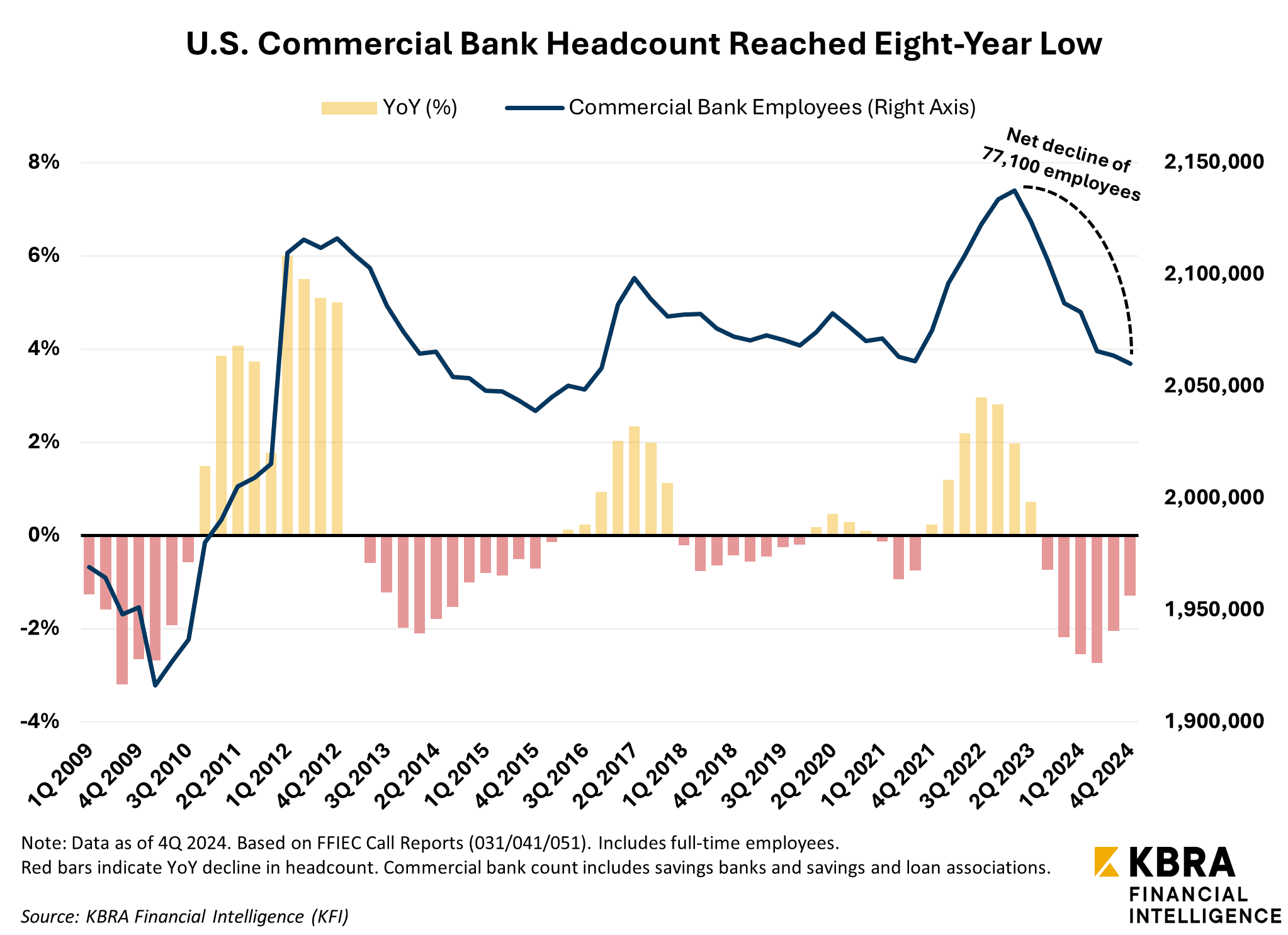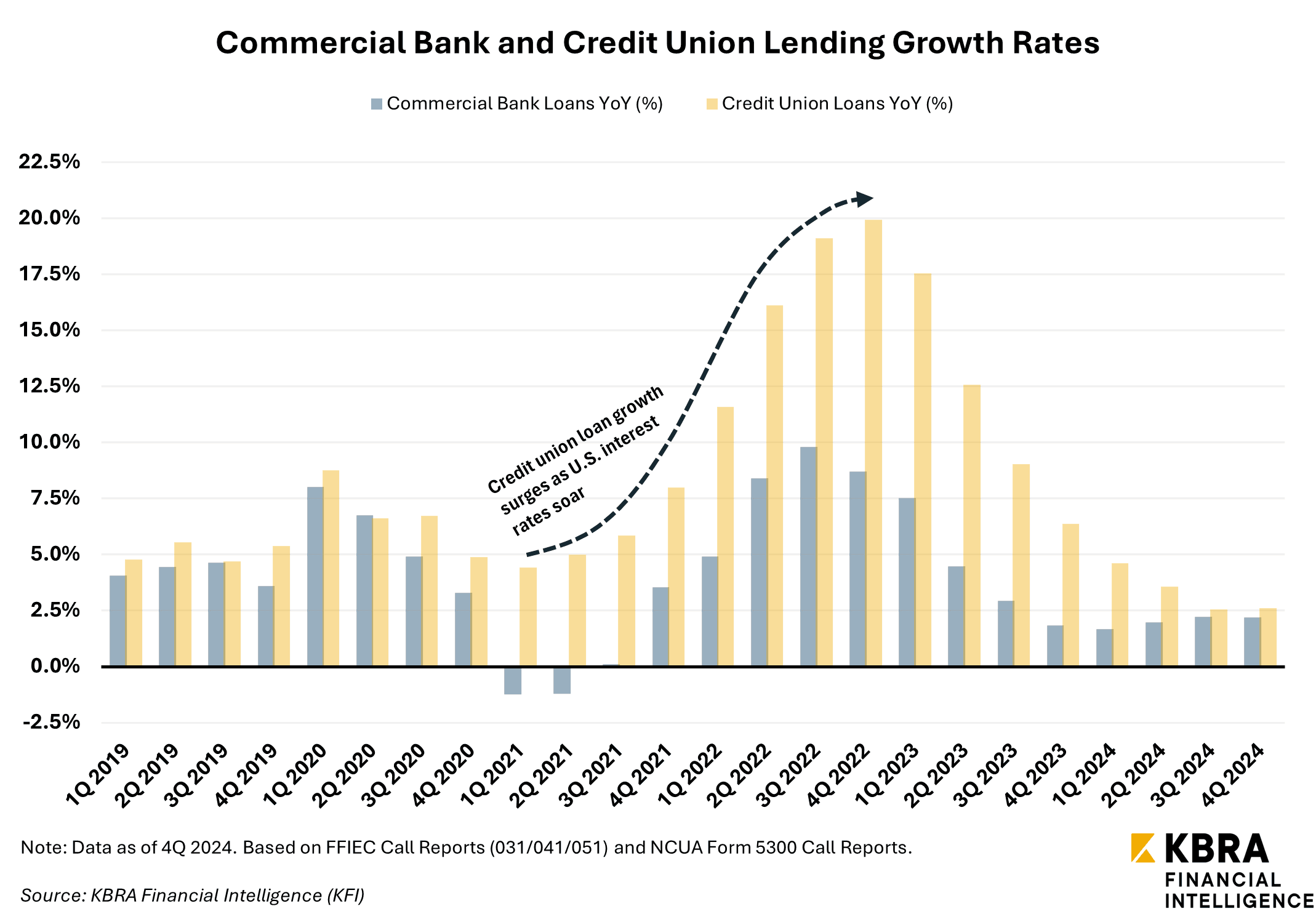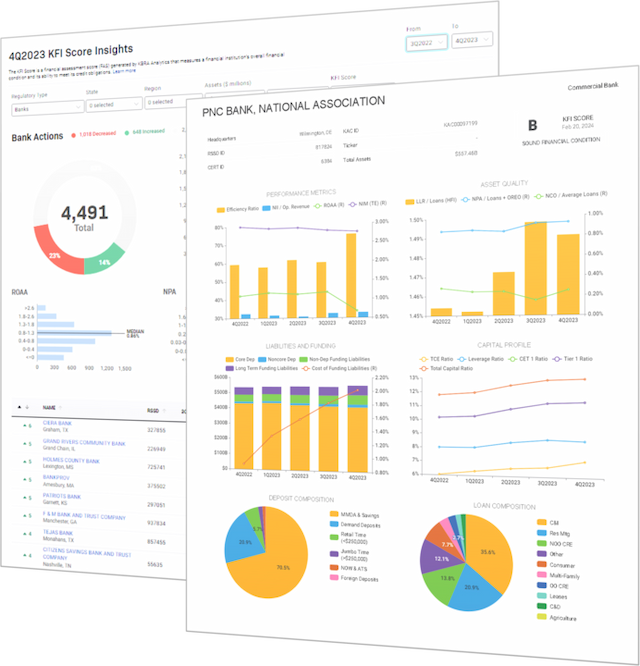KBRA Financial Intelligence
Shifting Growth Forecasts May Foment Financial Sector Layoffs
By KFI Staff
Payroll Data Show Financial Firms Hiring Strongly
March’s nonfarm payrolls release surprised forecasters to the upside, as job creation increased to its fastest rate of 2025. Despite this, the sum of the past three months of data showed the rate of U.S. job creation slowed by 27% from the 4Q 2024, with a net 456,000 jobs being added to the economy throughout 1Q 2025.
Breaking that down to the industry level, this year has seen more substantial employment strength in Financial Activities, a category used by the Bureau of Labor Statistics (BLS). A net gain of 39,000 jobs throughout 1Q 2025 was the strongest quarterly increase in the industry’s estimated employment level since 2022.

Banks and Credit Unions’ Divergent Headcount Trends
Although employment figures captured by the Financial Activities category include both commercial bank and credit union employees, KBRA Financial Intelligence (KFI) noted in January that these two institution types have largely followed separate paths in net hiring throughout the past two years. KFI data shows that commercial bank headcount (which includes savings banks and savings and loan associations for this analysis) slumped to an eight-year low in 4Q 2024. The net decline from the peak headcount in 1Q 2023 has been equivalent to more than 77,000 employees.
By contrast, credit union full-time headcount jumped to an all-time high in 3Q 2024. Though credit unions did cut 1,545 workers in 4Q 2024, they still collectively added 3,045 employees—a nearly 1% increase in total headcount—throughout the full year. Full-time credit union employees numbered roughly 345,000 at the end of 2024, representing less than one-fifth of the nation’s 2.1 million full-time commercial bank employees, but marking an increase of 8.8% throughout the past three years of data. Over that same span, commercial banks saw a decline in headcount of 0.7%.

KFI has found that the recent divergence in hiring trends correlates with a wide gap in lending growth between the two institution types over the past three years. During that period, total credit union loans increased by almost 31%, more than double the 14% growth rate of total commercial bank loans, indicating that the divergence in headcount correlates with persistently stronger growth in lending assets held by credit unions. One factor driving more aggressive lending growth at credit unions has been the rate advantages offered amid tightening monetary policy in 2022-23. Though credit unions generally offer fewer products than their commercial bank counterparts, these lenders typically pay higher rates to depositors and offer lower rates to their borrowers, which becomes a particularly attractive proposition when rates surge, and consumers are likely to become more sensitive to their expenditures on interest payments.

Emerging Growth Scare Could Change Hiring Plans
In addition to the BLS data on payrolls, executive outplacement firm Challenger, Gray & Christmas last week released its latest monthly tally of U.S. job cuts. Though it estimates that 2025 job cuts through March have boomed 93% year-over-year (YoY), reaching their fastest pace since 2009, these cuts have largely been concentrated in the government sector. Challenger’s count of job cuts excluding government are largely in line with the previous year. The financial sector is ranked as the fifth-largest source of 2025 job cuts at 15,982, but this figure is down 44% YoY.
KFI has highlighted sizable job cuts impacting tens of thousands of positions at banks like Citigroup (KFI Score: B+) and Ally Financial (KFI Score: B-) early this year, which have now been compounded by announcements of further headcount reductions at JPMorgan Chase & Co. (KFI Score: B+) and Morgan Stanley (KFI Score: A-), but it remains to be seen whether these will accelerate the already steady pace of layoffs and job cuts impacting the banking sector.
A key factor that could deepen job cuts among banks is the tariff turmoil that has slammed financial markets and could force banks to revise their economic growth forecasts. In the wake of the White House’s broad increase to duties charged on imported goods to the U.S., The Goldman Sachs Group (KFI Score: B+) analysts lowered their GDP growth forecast for 2025 and ramped up the probability of a recession within the next 12 months to 45%. Those odds have increased from 35% just a week ago. If banks are rapidly adjusting their expectations for growth in the year ahead, it is possible that their hiring plans could also be disrupted.
KFI has recently analyzed the potential negative impact of tariffs on construction and auto lending, which are already experiencing contraction on an annual basis. KFI users can sort by loan categories and the delinquency rate impacting those loans for all banks and credit unions via our web application, the Data Wizard in KFI’s Excel add-in, as well as the Loan Category and Delinquency Report template from our Template Library. To access our full library of tables and templates, request a demo today.

